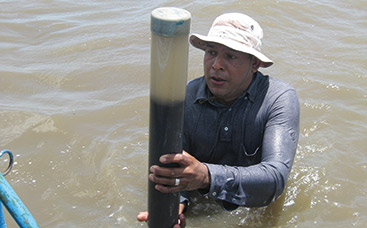Tracking pollution to ist source

Tracking pollution to ist source
Isotopic techniques are helping to identify nitrate sources and estimate their contributions to water pollution.

Experts will identify the sources of nitrate pollution in the Great Lakes of Nicaragua using information on the isotopic signatures for nitrogen, oxygen and boron from water samples collected during rainy and base flow periods.
© Sakadevan
The fertile soil surrounding the Great Lakes of Nicaragua provides the ideal conditions for cattle farming and plantations. However, poor agricultural practices allow fertilisers to run off into streams and collect in lake water. As a result, the last two decades have seen the Great Lakes suffer from a build up of excess nutrients at an accelerated pace.
Nutrient pollution is a pressure that Danube countries know all too well. Excessive nutrients – especially nitrogen and phosphorus – enter the Danube Basin mostly from agricultural sources and disturb the ecological balance of the river and the Black Sea. These nutrients encourage phytoplankton to grow and reproduce more rapidly causing algal blooms, which can block sunlight to plants below the surface and deplete oxygen in the water, killing off other aquatic life.
To combat nutrient pollution, water managers at sites such as the Great Lakes of Nicaragua are turning to isotopes to identify the source of pollution.
Using isotopic and nuclear techniques.
The International Atomic Energy Agency (IAEA) and Food and Agriculture Organisation (FAO) through the Soil and Water Management and Crop Nutrition Section in the Joint IAEA/FAO Division of Nuclear Techniques in Food and Agriculture (the Joint Division) is supporting its Member States to reduce agricultural pollution using isotopic and nuclear techniques.
Isotopes are variants of a particular chemical element; while all isotopes of a given element have the same number of protons in each atom, they differ in the number of neutrons. Nitrates originating from different pollution sources have a distinctive isotopic signature and it is possible to measure such ratios in water. Analysis of non-radioactive, or stable, isotopes can be used to identify the nitrate sources and to estimate their contribution to nitrate pollution.
In a complex natural environment, nitrates undergo rapid transformation, which can complicate the identification of nitrate sources in agricultural landscapes. To overcome this, the fingerprint of a third isotope – boron – is used for efficient discrimination of different sources. This dual isotopic tracer technique is being used to identify sources of nitrate pollution and develop management strategies for the Great Lakes of Nicaragua as well as Inle Lake in Myanmar.
Getting at the source of pollution. Unsustainable agricultural practices, deforestation and a rapid boom in tourism in and around the Inle watershed areas of Myanmar have accelerated the deterioration of water quality. As a result, the socio-economic, environmental and ecosystem support provided by the lake has gradually decreased over the past several years. To address the environmental pressures of the area, the government of Myanmar initiated an integrated watershed management approach. Under this approach, determining sources of nitrate pollution will be a key component in developing land use and management practices to reduce nitrogen loads and improve water quality in the lake.
For both Inle and the Great Lakes of Nicaragua systems, these projects will collect water samples during rainy and base flow periods and measure the isotopic signatures for nitrogen, oxygen and boron. Using that information and by analysing land use practices in the catchments, experts will identify the sources of nitrate pollution in the area.
Monitoring lakes and rivers for water quality provide information on the trend and overall status of the quality of surface waters. However, only by knowing and identifying the sources of nitrates can farm management practices be introduced to improve and reduce such pollution and protect water quality for the future.

To address the environmental pressures of Inle Lake, Myanmar – including unsustainable agricultural practices, deforestation, and a rapid boom in tourism in the area – the government of Myanmar has initiated an integrated watershed management approach.
Nuclear Techniques in Food and Agriculture
In the past, the Joint Division has worked with its Member States to reduce soil erosion and sedimentation through soil conservation measures using fallout radionuclides (FRN) and compound specific stable isotope (CSSI) techniques. These help quantify land use impacts of soil erosion and identify erosion hotspots in agricultural landscapes. For more information on these techniques, please visit:
http://www-naweb.iaea.org/nafa/swmn/index.html. Comprehensive guidelines for this work can be found here.





